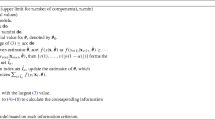The aim of this paper is to investigate the mixture index of fit in hypothesis testing problems from the point of view of robustness. The concept of contamination plot is introduced and an algorithm is proposed to determine it. Our algorithm is a remarkable application of the widely used EM algorithm by involving a two-phase M-step procedure. In the parametric phase the parameters of the model in the null hypothesis are estimated using the maximum likelihood method, while in the nonparametric phase the contaminating distribution is determined by a filling technique. It is proved that the objective function decreases monotonically during the iterations. Finally, the algorithm is applied and discussed when the hypothesis of independence is tested for contingency tables.
Similar content being viewed by others
References
R. R. Bahadur, “Stochastic comparison of tests,” Ann. Math. Stat., 31, 276–295 (1960).
R. R. Bahadur, Some Limit Theorems in Statistics, SIAM, Philadelphia (1971).
I. Csisz’ar, M. Isp’any, Gy. Michaletzky, T. Rudas, G. Tusn’ady, and E. Verdes, “Divergence minimization under prior inequality constraints,” in: Proceedings of the IEEE International Symposium on Information Theory, Washington (2001), p. 21.
P. Diaconis and B. Efron, “Testing for independence in a two-way contingency table: new interpretations of the chi–square statistics,” Ann. Stat., 13, 845–874 (1985).
A.P. Dempster, N.M. Laird, and D. B. Rubin, “Maximum likelihood from incomplete data via the EM algorithm,” J. Roy. Stat. Soc. B, 39, 1–22 (1977).
D. L. Donoho and R. C. Liu, “The ‘automatic’ robustness of minimum distance functionals,” Ann. Stat., 16, 552–586 (1988).
A. K. Formann, “Testing the Rasch model by means of the mixture fit index,” Br. J. Mat. Stat. Psychol., 59, 89–95 (2006).
S. Heritier and E. Ronchetti, “Robust bounded-influence tests in general parametric models,” J. Am. Stat. Assoc., 89, 897–904 (1994).
P. J. Huber, Robust Statistics, Wiley, New York (1981).
P. J. Huber and V. Strassen, “Minimax tests and the Neyman–Pearson lemma for capacities,” Ann. Stat., 1, 251–263 (1973).
T. Ibaraki and N. Katoh, Resource Allocation Problems. Algorithmic Approaches, MIT Press, Cambridge (1988).
J. Liu, and B.G. Lindsay, “Building and using semiparametric tolerance regions for parametric multinomial models,” Ann. Stat., 37, 3644–3659 (2009).
M. Markatou, W.A. Stahel, and E. Ronchetti, “Robust M-type testing procedures for linear models,” in: Directions in Robust Statistics and Diagnostics I, W. Stahel and S. Weisberg (eds.), Springer, New York (1991), pp. 201–220.
G. J. McLachlan and T. Krishnan, The EM Algorithm and Extensions, Wiley, New York (1997).
T.R.C. Read and N.A.C. Cressie, Goodness-of-fit Statistics for Discrete Multivariate Analysis, Springer, New York (1988).
J. Revuelta, “Estimating the π∗ goodness of fit index for finite mixtures of item response models,” Br. J. Mat. Stat. Psychol., 61, 93–113 (2008).
T. Rudas, C.C. Clogg, and B.G. Lindsay, “A new index of fit based on mixture method for the analysis of contingency tables,” J. Roy. Stat. Soc. B, 56, 623–639 (1994).
R. Snee, “Graphical display of two-way contingency table,” Am. Stat., 38, 9–12 (1987).
G. Tusn’ady, “On asymptotically optimal tests,” Ann. Stat., 5, 385–393 (1977).
P.H. Zipkin, “Simple ranking methods for allocation of one resource,” Manage. Sci., 26, 34–43 (1980).
E. Verdes, “Finding and characterization of local optima in the π∗ problem for two-way contingency tables,” Stud. Math. Hung., 36, 471–480 (2000).
L. Xi, Measuring goodness-of-fit in the analysis of contingency tables with mixture based indices: Algorithms, asymptotics and inference, PhD Dissertation, Pennsylvania State Univ. (1996).
L. Xi and B.G. Lindsay, “A note on calculating the π∗ index of fit for the analysis of contingency tables,” Sociol. Methods Res., 25, 248–259 (1996).
Author information
Authors and Affiliations
Corresponding author
Additional information
Proceedings of the XXVI International Seminar on Stability Problems for Stochastic Models, Sovata-Bai, Romania, August 27 – September 2, 2006.
Rights and permissions
About this article
Cite this article
Isp’any, M., Verdes, E. ON the Robustness of Mixture Index of Fit. J Math Sci 200, 432–440 (2014). https://doi.org/10.1007/s10958-014-1925-9
Published:
Issue Date:
DOI: https://doi.org/10.1007/s10958-014-1925-9




